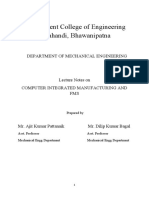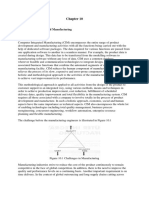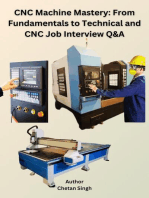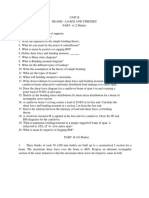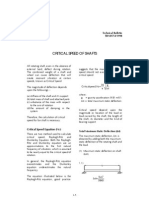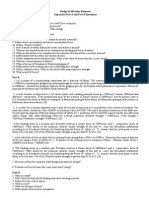Computer Integrated Manufacturing
Computer Integrated Manufacturing
Uploaded by
ILAYAPERUMAL KCopyright:
Available Formats
Computer Integrated Manufacturing
Computer Integrated Manufacturing
Uploaded by
ILAYAPERUMAL KCopyright
Available Formats
Share this document
Did you find this document useful?
Is this content inappropriate?
Copyright:
Available Formats
Computer Integrated Manufacturing
Computer Integrated Manufacturing
Uploaded by
ILAYAPERUMAL KCopyright:
Available Formats
CHAPTER
COMPUTER INTEGRATED MANUFACTURING
An overview of CIM is presented in this chapter. A brief account of the evolution of CIM is included. The major functions carried out in a manufacturing plant are surveyed and the different levels of integration are identified.
1.1 INTRODUCTION Computer Integrated Manufacturing (CIM) encompasses the entire range of product development and manufacturing activities with all the functions being carried out with the help of dedicated software packages. The data required for various functions are passed from one application software to another in a seamless manner. For example, the product data is created during design. This data has to be transferred from the modeling software to manufacturing software without any loss of data. CIM uses a common database wherever feasible and communication technologies to integrate design, manufacturing and associated business functions that combine the automated segments of a factory or a manufacturing facility. CIM reduces the human component of manufacturing and thereby relieves the process of its slow, expensive and error-prone component. CIM stands for a holistic and methodological approach to the activities of the manufacturing enterprise in order to achieve vast improvement in its performance. This methodological approach is applied to all activities from the design of the product to customer support in an integrated way, using various methods, means and techniques in order to achieve production improvement, cost reduction, fulfillment of scheduled delivery dates, quality improvement and total flexibility in the manufacturing system. CIM requires all those associated with a company to involve totally in the process of product development and manufacture. In such a holistic approach, economic, social and human aspects have the same importance as technical aspects. CIM also encompasses the whole lot of enabling technologies including total quality management, business process reengineering, concurrent engineering, workflow automation, enterprise resource planning and flexible manufacturing. A distinct feature of manufacturing today is mass customization. This implies that though the products are manufactured in large quantities, products must incorporate
CAD/CAM/CIM
customer-specific changes to satisfy the diverse requirements of the customers. This requires extremely high flexibility in the manufacturing system. The challenge before the manufacturing engineers is illustrated in Fig.1.1.
QUALITY
COST
DELIVERY TIME
Fig.1.1 Challenges in Manufacturing
Manufacturing industries strive to reduce the cost of the product continuously to remain competitive in the face of global competition. In addition, there is the need to improve the quality and performance levels on a continuing basis. Another important requirement is on time delivery. In the context of global outsourcing and long supply chains cutting across several international borders, the task of continuously reducing delivery times is really an arduous task. CIM has several software tools to address the above needs. Manufacturing engineers are required to achieve the following objectives to be competitive in a global context. Reduction in inventory Lower the cost of the product Reduce waste Improve quality Increase flexibility in manufacturing to achieve immediate and rapid response to: Product changes Production changes Process change Equipment change Change of personnel CIM technology is an enabling technology to meet the above challenges to the manufacturing.
Computer Integrated Manufacturing
The advances in automation have enabled industries to develop islands of automation. Examples are flexible manufacturing cells, robotized work cells, flexible inspection cells etc. One of the objectives of CIM is to achieve the consolidation and integration of these islands of automation. This requires sharing of information among different applications or sections of a factory, accessing incompatible and heterogeneous data and devices. The ultimate objective is to meet the competition by improved customer satisfaction through reduction in cost, improvement in quality and reduction in product development time. CIM makes full use of the capabilities of the digital computer to improve manufacturing. Two of them are: i. Variable and Programmable automation ii. Real time optimization The computer has the capability to accomplish the above for hardware components of manufacturing (the manufacturing machinery and equipment) and software component of manufacturing (the application software, the information flow, database and so on). The capabilities of the computer are thus exploited not only for the various bits and pieces of manufacturing activity but also for the entire system of manufacturing. Computers have the tremendous potential needed to integrate the entire manufacturing system and thereby evolve the computer integrated manufacturing system. 1.2 TYPES OF MANUFACTURING The term manufacturing covers a broad spectrum of activities. Metal working industries, process industries like chemical plants, oil refineries, food processing industries, electronic industries making microelectronic components, printed circuit boards, computers and entertainment electronic products etc. are examples of manufacturing industries. Manufacturing involves fabrication, assembly and testing in a majority of situations. However, in process industries operations are of a different nature. Manufacturing industries can be grouped into four categories: i. Continuous Process Industries In this type of industry, the production process generally follows a specific sequence. These industries can be easily automated and computers are widely used for process monitoring, control and optimization. Oil refineries, chemical plants, food processing industries, etc are examples of continuous process industries. ii. Mass Production Industries Industries manufacturing fasteners (nuts, bolts etc.), integrated chips, automobiles, entertainment electronic products, bicycles, bearings etc. which are all mass produced can be classified as mass production industries. Production lines are specially designed and optimized to ensure automatic and cost effective operation. Automation can be either fixed type or flexible.
Chapter 1
CAD/CAM/CIM
iii. Batch Production (Discrete Manufacturing) The largest percentage of manufacturing industries can be classified as batch production industries. The distinguishing features of this type of manufacture are the small to medium size of the batch, and varieties of such products to be taken up in a single shop. Due to the variety of components handled, work centres should have broader specifications. Another important fact is that small batch size involves loss of production time associated with product changeover. As mentioned earlier, integration of computer in process industries for production automation, process monitoring and control and optimization is relatively easy. In the case of mass production and batch production computer integration faces a number of problems as there are a large number of support activities which are to be tied together. These are discussed in detail later in this chapter. Automation of manufacture has been implemented using different techniques since the turn of the 20th Century. Fixed automation is the first type to emerge. Single spindle automatic lathe, multi spindle automatic lathe and transfer lines are examples of fixed automation. Fixed automation using mechanical, electrical, pneumatic and hydraulic systems is widely used in automobile manufacturing. This type of automation has a severe limitation - these are designed for a particular product and any product change will require extensive modifications to the automation system. The concept of programmable automation was introduced later. These were electrically controlled systems and programs were stored in punched cards and punched tapes. Typical examples of programmable automation are: i. Electrical programme controlled milling machines ii. Hydraulically operated Automatic lathes with programmable control drum iii. Sequencing machines with punched card control /plug board control Development of digital computers, microelectronics and microprocessors significantly altered the automation scenario during 1950-1990. Machine control systems are now designed around microprocessors and microelectronics is part and parcel of industrial drives and control. The significant advances in miniaturization through integration of large number of components into small integrated chips and the consequent improvement in reliability and performance have increased the popularity of microelectronics. This has resulted in the availability of high performance desktop computing machines as well as file servers which can be used for industrial control with the help of application software packages. 1.3 EVOLUTION OF COMPUTER INTEGRATED MANUFACTURING Computer Integrated Manufacturing (CIM) is considered a natural evolution of the technology of CAD/CAM which by itself evolved by the integration of CAD and CAM. Massachusetts Institute of Technology (MIT, USA) is credited with pioneering the
Computer Integrated Manufacturing
development in both CAD and CAM. The need to meet the design and manufacturing requirements of aerospace industries after the Second World War necessitated the development these technologies. The manufacturing technology available during late 40s and early 50s could not meet the design and manufacturing challenges arising out of the need to develop sophisticated aircraft and satellite launch vehicles. This prompted the US Air Force to approach MIT to develop suitable control systems, drives and programming techniques for machine tools using electronic control. The first major innovation in machine control is the Numerical Control (NC), demonstrated at MIT in 1952. Early Numerical Control Systems were all basically hardwired systems, since these were built with discrete systems or with later first generation integrated chips. Early NC machines used paper tape as an input medium. Every NC machine was fitted with a tape reader to read paper tape and transfer the program to the memory of the machine tool block by block. Mainframe computers were used to control a group of NC machines by mid 60s. This arrangement was then called Direct Numerical Control (DNC) as the computer bypassed the tape reader to transfer the program data to the machine controller. By late 60s mini computers were being commonly used to control NC machines. At this stage NC became truly soft wired with the facilities of mass program storage, offline editing and software logic control and processing. This development is called Computer Numerical Control (CNC). Since 70s, numerical controllers are being designed around microprocessors, resulting in compact CNC systems. A further development to this technology is the distributed numerical control (also called DNC) in which processing of NC program is carried out in different computers operating at different hierarchical levels - typically from mainframe host computers to plant computers to the machine controller. Today the CNC systems are built around powerful 32 bit and 64 bit microprocessors. PC based systems are also becoming increasingly popular. Manufacturing engineers also started using computers for such tasks like inventory control, demand forecasting, production planning and control etc. CNC technology was adapted in the development of co-ordinate measuring machines (CMMs) which automated inspection. Robots were introduced to automate several tasks like machine loading, materials handling, welding, painting and assembly. All these developments led to the evolution of flexible manufacturing cells and flexible manufacturing systems in late 70s. Evolution of Computer Aided Design (CAD), on the other hand was to cater to the geometric modeling needs of automobile and aeronautical industries. The developments in computers, design workstations, graphic cards, display devices and graphic input and output devices during the last ten years have been phenomenal. This coupled with the development of operating system with graphic user interfaces and powerful interactive (user friendly) software packages for modeling, drafting, analysis and optimization provides the necessary tools to automate the design process. CAD in fact owes its development to the APT language project at MIT in early 50s. Several clones of APT were introduced in 80s to automatically develop NC codes from
Chapter 1
CAD/CAM/CIM
the geometric model of the component. Now, one can model, draft, analyze, simulate, modify, optimize and create the NC code to manufacture a component and simulate the machining operation sitting at a computer workstation. If we review the manufacturing scenario during 80s we will find that the manufacturing is characterized by a few islands of automation. In the case of design, the task is well automated. In the case of manufacture, CNC machines, DNC systems, FMC, FMS etc provide tightly controlled automation systems. Similarly computer control has been implemented in several areas like manufacturing resource planning, accounting, sales, marketing and purchase. Yet the full potential of computerization could not be obtained unless all the segments of manufacturing are integrated, permitting the transfer of data across various functional modules. This realization led to the concept of computer integrated manufacturing. Thus the implementation of CIM required the development of whole lot of computer technologies related to hardware and software. 1.4 CIM HARDWARE AND CIM SOFTWARE CIM Hardware comprises the following: i. Manufacturing equipment such as CNC machines or computerized work centres, robotic work cells, DNC/FMS systems, work handling and tool handling devices, storage devices, sensors, shop floor data collection devices, inspection machines etc. ii. Computers, controllers, CAD/CAM systems, workstations / terminals, data entry terminals, bar code readers, RFID tags, printers, plotters and other peripheral devices, modems, cables, connectors etc., CIM software comprises computer programmes to carry out the following functions: Management Information System Sales Marketing Finance Database Management Modeling and Design Analysis Simulation Communications Monitoring Production Control Manufacturing Area Control Job Tracking
Computer Integrated Manufacturing
Inventory Control Shop Floor Data Collection Order Entry Materials Handling Device Drivers Process Planning Manufacturing Facilities Planning Work Flow Automation Business Process Engineering Network Management Quality Management 1.5 NATURE AND ROLE OF THE ELEMENTS OF CIM SYSTEM Nine major elements of a CIM system are in Fig 1.2. They are: Marketing Product Design Planning Purchase Manufacturing Engineering Factory Automation Hardware Warehousing Logistics and Supply Chain Management Finance Information Management
Fig.1.2 Major Elements of a CIM System
Chapter 1
CAD/CAM/CIM
i. Marketing: The need for a product is identified by the marketing division. The specifications of the product, the projection of manufacturing quantities and the strategy for marketing the product are also decided by the marketing department. Marketing also works out the manufacturing costs to assess the economic viability of the product. ii. Product Design: The design department of the company establishes the initial database for production of a proposed product. In a CIM system this is accomplished through activities such as geometric modeling and computer aided design while considering the product requirements and concepts generated by the creativity of the design engineer. Configuration management is an important activity in many designs. Complex designs are usually carried out by several teams working simultaneously, located often in different parts of the world. The design process is constrained by the costs that will be incurred in actual production and by the capabilities of the available production equipment and processes. The design process creates the database required to manufacture the part. iii. Planning: The planning department takes the database established by the design department and enriches it with production data and information to produce a plan for the production of the product. Planning involves several subsystems dealing with materials, facility, process, tools, manpower, capacity, scheduling, outsourcing, assembly, inspection, logistics etc. In a CIM system, this planning process should be constrained by the production costs and by the production equipment and process capability, in order to generate an optimized plan. iv. Purchase: The purchase departments is responsible for placing the purchase orders and follow up, ensure quality in the production process of the vendor, receive the items, arrange for inspection and supply the items to the stores or arrange timely delivery depending on the production schedule for eventual supply to manufacture and assembly. v. Manufacturing Engineering: Manufacturing Engineering is the activity of carrying out the production of the product, involving further enrichment of the database with performance data and information about the production equipment and processes. In CIM, this requires activities like CNC programming, simulation and computer aided scheduling of the production activity. This should include online dynamic scheduling and control based on the real time performance of the equipment and processes to assure continuous production activity. Often, the need to meet fluctuating market demand requires the manufacturing system flexible and agile. Factory Automation Hardware: Factory automation equipment further enriches vi. the database with equipment and process data, resident either in the operator or the equipment to carry out the production process. In CIM system this consists of computer controlled process machinery such as CNC machine tools, flexible
Computer Integrated Manufacturing
manufacturing systems (FMS), Computer controlled robots, material handling systems, computer controlled assembly systems, flexibly automated inspection systems and so on. vii. Warehousing: Warehousing is the function involving storage and retrieval of raw materials, components, finished goods as well as shipment of items. In todays complex outsourcing scenario and the need for just-in-time supply of components and subsystems, logistics and supply chain management assume great importance. viii. Finance: Finance deals with the resources pertaining to money. Planning of investment, working capital, and cash flow control, realization of receipts, accounting and allocation of funds are the major tasks of the finance departments.
Fig.1.3 Various Activities in CIM
FEM - Finite Element Modeling MeM - Mechanism Modeling ERP - Enterprise Resource Planning ix. Information Management: Information Management is perhaps one of the crucial tasks in CIM. This involves master production scheduling, database management, communication, manufacturing systems integration and management information systems. It can be seen from Fig 1.3 that CIM technology ties together all the manufacturing and related functions in a company. Implementation of CIM technology thus involves basically integration of all the activities of the enterprise.
Chapter 1
10
CAD/CAM/CIM
1.6 DEVELOPMENT OF CIM CIM is an integration process leading to the integration of the manufacturing enterprise. Fig 1.4 indicates different levels of this integration that can be seen within an industry. Dictated by the needs of the individual enterprise this process usually starts with the need to interchange information between the some of the so called islands of automation. Flexible manufacturing cells, automatic storage and retrieval systems, CAD/CAM based design etc. are the examples of islands of automation i.e. a sort of computer based automation achieved completely in a limited sphere of activity of an enterprise. This involves data exchange among computers, NC machines, robots, gantry systems etc. Therefore the integration process has started bottom up. The interconnection of physical systems was the first requirement to be recognized and fulfilled.
Fig. 1.4 Levels of Integration Against Evolution of CIM
The next level of integration, application integration in Fig 1.4 is concerned with the integration of applications, the term applications being used in the data processing sense. The applications are those which are discussed in section 1.4 under the heading CIM hardware and software. Application integration involves supply and retrieval of information, communication between application users and with the system itself. Thus the application integration level imposes constraints on the physical integration level. There has to be control of the applications themselves also.
Computer Integrated Manufacturing
11
QUESTIONS 1. Describe the need for CIM and the issues addressed by CIM. 2. What are the different types of manufacturing? Make an assessment of the extent of computer control in specific cases of each types of manufacturing. 3. What are the various activities of a manufacturing plant which can be carried out through computer control? 4. Discuss the main elements of CIM systems. 5. Differentiate among physical integration, application integration and business integration. Give specific examples of each.
Chapter 1
The highest level of integration, business integration in Fig.1.4 is concerned with the management and operational processes of an enterprise. The management process provides supervisory control of the operational process which in turn co-ordinates the day-to-day execution of the activities at the application level. The business integration level therefore places constraints on the application level. This level offers considerable challenge to the integration activity.
12
CAD/CAM/CIM
Computer Integrated Manufacturing
13
Chapter 1
14
CAD/CAM/CIM
You might also like
- Me-804 Cad Cam Cim - 1Document17 pagesMe-804 Cad Cam Cim - 1Mallesham DevasaneNo ratings yet
- Computer Integrated ManufacturingDocument14 pagesComputer Integrated ManufacturingDare RedevilNo ratings yet
- CADCAM Lecture NotesDocument223 pagesCADCAM Lecture NotesAnish KulkarniNo ratings yet
- Computer Integrated Manufacturing (CIM) - UNIT 1Document12 pagesComputer Integrated Manufacturing (CIM) - UNIT 1Memoh BranleyNo ratings yet
- Tipos de ManufacturaDocument3 pagesTipos de Manufacturaluis gerardoNo ratings yet
- Government College of Engineering Kalahandi, BhawanipatnaDocument26 pagesGovernment College of Engineering Kalahandi, BhawanipatnaRaghuNo ratings yet
- ME-6703-Computer Integrated Manufacturing: Unit-IDocument8 pagesME-6703-Computer Integrated Manufacturing: Unit-IJayakrishnaNo ratings yet
- Me18702 CimDocument45 pagesMe18702 CimDharun prakash MNo ratings yet
- ME-6703-Computer Integrated Manufacturing: Unit-IDocument8 pagesME-6703-Computer Integrated Manufacturing: Unit-IBalaji ElangovanNo ratings yet
- ME-6703-Computer Integrated Manufacturing: Unit-IDocument8 pagesME-6703-Computer Integrated Manufacturing: Unit-Imani manisNo ratings yet
- Notes On Cad/Cam/Cim: By: Krishankant KankarDocument5 pagesNotes On Cad/Cam/Cim: By: Krishankant KankarMallesham DevasaneNo ratings yet
- Introduction To CIM Y.ZDocument21 pagesIntroduction To CIM Y.ZBizuayehu TadesseNo ratings yet
- Computer Integrated ManufacturingDocument45 pagesComputer Integrated ManufacturingVinoth KumarNo ratings yet
- Computer Aided ManufactureDocument15 pagesComputer Aided ManufactureAnonymous 5lXEgHNo ratings yet
- Unit - 1 Computer Integrated Manufacturing SystemsDocument29 pagesUnit - 1 Computer Integrated Manufacturing SystemsAbid YusufNo ratings yet
- Unit - 1 Computer Integrated Manufacturing SystemsDocument29 pagesUnit - 1 Computer Integrated Manufacturing Systemsbest4reverNo ratings yet
- Mechanical Engineering Computer-Integrated-manufacturing-systems Introduction NotesDocument29 pagesMechanical Engineering Computer-Integrated-manufacturing-systems Introduction NotesPranav SinghNo ratings yet
- Robotics Chapter 10 - Computer Integrated ManufacturingDocument7 pagesRobotics Chapter 10 - Computer Integrated Manufacturingtutorfelix777No ratings yet
- Computer Integrated Manufacturing (Cim)Document12 pagesComputer Integrated Manufacturing (Cim)Aditya Narayan SahooNo ratings yet
- Seminar Term Thesis Report FormatDocument13 pagesSeminar Term Thesis Report FormatchaitanyakolkataagarwalNo ratings yet
- Cim Unit 2 Summary Computer Integrated ManufacturingDocument41 pagesCim Unit 2 Summary Computer Integrated ManufacturingKULDEEP PALNo ratings yet
- Final Cam Unit 8Document14 pagesFinal Cam Unit 8prethiprathi18No ratings yet
- Computer Integrated Manufacturing in WTO ScenarioDocument7 pagesComputer Integrated Manufacturing in WTO Scenarioboss4840No ratings yet
- Cim KBDocument273 pagesCim KBtimketaNo ratings yet
- Computer Inegrated Manufacturing (Cim) (Handout)Document93 pagesComputer Inegrated Manufacturing (Cim) (Handout)Ebrahim Hakami100% (1)
- Seminar Paper Musthafa 2 (1)Document6 pagesSeminar Paper Musthafa 2 (1)mukta.p22357No ratings yet
- UNIT 1Document10 pagesUNIT 1Ritesh SinghNo ratings yet
- Computer Integrated ManufacturingDocument37 pagesComputer Integrated ManufacturingSatheesh SekarNo ratings yet
- 7 SEM ME3792 CIMS R 2021 MECHDocument14 pages7 SEM ME3792 CIMS R 2021 MECHdroganfire22No ratings yet
- 10 Me 61Document217 pages10 Me 61Vikram KedambadiNo ratings yet
- CIM Question BankDocument5 pagesCIM Question Bankselvi6496100% (1)
- Computer-Integrated Manufacturing (CIM)Document46 pagesComputer-Integrated Manufacturing (CIM)Sukanth KannanNo ratings yet
- CIM FundamentalsDocument36 pagesCIM Fundamentalsmohsinkhan_146No ratings yet
- Unit 1 Introduction To Cim: StructureDocument22 pagesUnit 1 Introduction To Cim: StructureIsmail ShaikNo ratings yet
- Learning Material: Department of Mechanical and Automation EngineeringDocument73 pagesLearning Material: Department of Mechanical and Automation EngineeringVipin SureshNo ratings yet
- The Role of ComputersDocument4 pagesThe Role of ComputersAbbas YerimaNo ratings yet
- Ijetae 0515 01Document5 pagesIjetae 0515 01ALI PAUL TOOCHUKWUNo ratings yet
- 5.5 CimDocument18 pages5.5 CimcjksdbvjkcsbNo ratings yet
- Computer Integrated Manufacturing (CIM) .Document5 pagesComputer Integrated Manufacturing (CIM) .BHAGYESH JHANWARNo ratings yet
- Computer Integrated ManufacturingDocument15 pagesComputer Integrated ManufacturingPrajwal JaiswalNo ratings yet
- Unit - Vi:: Applications in MechatronicsDocument14 pagesUnit - Vi:: Applications in MechatronicsViswanathanBalajiNo ratings yet
- Lecture 1-2, Introduction To CIM, Dr. Janakarajan RamkumarDocument38 pagesLecture 1-2, Introduction To CIM, Dr. Janakarajan RamkumarShubha Tambrahalli ChandrashekarNo ratings yet
- CH 1 CIM IntroductionDocument53 pagesCH 1 CIM IntroductionElias GebrekirosNo ratings yet
- Nptel - Ac.in Courses 112103174 Module1 Lec2 1Document2 pagesNptel - Ac.in Courses 112103174 Module1 Lec2 1ErPriyeRanjanNo ratings yet
- Cim Lecture TwoDocument54 pagesCim Lecture Twosamsonwasihun2No ratings yet
- Unit 1Document21 pagesUnit 1John Aubrey MatiasNo ratings yet
- CIMS Computer Integrated Manufacturing SystemDocument14 pagesCIMS Computer Integrated Manufacturing SystemarunagkNo ratings yet
- Computer Integrated Manufacturing: Presented byDocument30 pagesComputer Integrated Manufacturing: Presented bykarthiyuvenNo ratings yet
- CIM Presentation BestDocument18 pagesCIM Presentation BestAqib mustafaNo ratings yet
- Computer Integrated Manufacturing SystemsDocument10 pagesComputer Integrated Manufacturing SystemsharishNo ratings yet
- Computer-Integrated ManufacturingDocument5 pagesComputer-Integrated ManufacturingNhan LeNo ratings yet
- Week 1-1Document14 pagesWeek 1-1jayashankarls965No ratings yet
- Understanding the Industrial Internet the $$$ Trillion Opportunities for Your EnterprisesFrom EverandUnderstanding the Industrial Internet the $$$ Trillion Opportunities for Your EnterprisesNo ratings yet
- Practical, Made Easy Guide To Building, Office And Home Automation Systems - Part OneFrom EverandPractical, Made Easy Guide To Building, Office And Home Automation Systems - Part OneNo ratings yet
- CNC Machine Mastery: From Fundamentals to Technical and CNC Job Interview Q&AFrom EverandCNC Machine Mastery: From Fundamentals to Technical and CNC Job Interview Q&ANo ratings yet
- QB114462Document8 pagesQB114462ILAYAPERUMAL KNo ratings yet
- 2-Critical Speed of ShaftDocument5 pages2-Critical Speed of ShaftRidani Faulika Amma100% (3)
- Private Car Policy WordingDocument9 pagesPrivate Car Policy WordingILAYAPERUMAL KNo ratings yet
- Madeeasy List NitDocument1 pageMadeeasy List NitILAYAPERUMAL KNo ratings yet
- ME6503 Design of Machine Elements Question BankDocument9 pagesME6503 Design of Machine Elements Question BankILAYAPERUMAL KNo ratings yet
- Merit Vol II Issue IV - April 2015 (LO)Document13 pagesMerit Vol II Issue IV - April 2015 (LO)ILAYAPERUMAL KNo ratings yet
- Lecture (1) Properties of Fluids: LecturerDocument28 pagesLecture (1) Properties of Fluids: LecturerILAYAPERUMAL KNo ratings yet
- GATE 2017 Exam Pattern: Section No. No. of Questions Marks Per Total MarksDocument1 pageGATE 2017 Exam Pattern: Section No. No. of Questions Marks Per Total MarksILAYAPERUMAL KNo ratings yet
- Kinematics of MachineryDocument8 pagesKinematics of MachineryILAYAPERUMAL KNo ratings yet
- Madeeasy List IitDocument1 pageMadeeasy List IitILAYAPERUMAL KNo ratings yet
- Academic Performance of Affiliated Colleges 042014Document19 pagesAcademic Performance of Affiliated Colleges 042014ILAYAPERUMAL KNo ratings yet
- About The Institution Organizing Committee Chief Patrons: Chairman, Rajalakshmi InstitutionsDocument2 pagesAbout The Institution Organizing Committee Chief Patrons: Chairman, Rajalakshmi InstitutionsILAYAPERUMAL KNo ratings yet
- Calories - Servings For 2400 CaloriesDocument1 pageCalories - Servings For 2400 CaloriesILAYAPERUMAL KNo ratings yet
- Intelligent Vision Based Mobile Robot For Pipe Line Inspection and CleaningDocument5 pagesIntelligent Vision Based Mobile Robot For Pipe Line Inspection and CleaningILAYAPERUMAL KNo ratings yet
- Academic Performance of Affiliated Colleges 112014Document19 pagesAcademic Performance of Affiliated Colleges 112014ILAYAPERUMAL KNo ratings yet
- Pearson Gate 2016 Detailed Analysis MeDocument4 pagesPearson Gate 2016 Detailed Analysis MeILAYAPERUMAL KNo ratings yet
- DME Question BankDocument4 pagesDME Question BankILAYAPERUMAL KNo ratings yet
- Section 6Document133 pagesSection 6ILAYAPERUMAL K100% (2)
- 3.10. Elements: GUI-Inaccessible Elements New Elements Modified Elements Undocumented Elements Archived ElementsDocument8 pages3.10. Elements: GUI-Inaccessible Elements New Elements Modified Elements Undocumented Elements Archived ElementsILAYAPERUMAL KNo ratings yet
- Engineering Graphics2Document7 pagesEngineering Graphics2ILAYAPERUMAL KNo ratings yet
- Section 10Document16 pagesSection 10ILAYAPERUMAL K100% (1)





